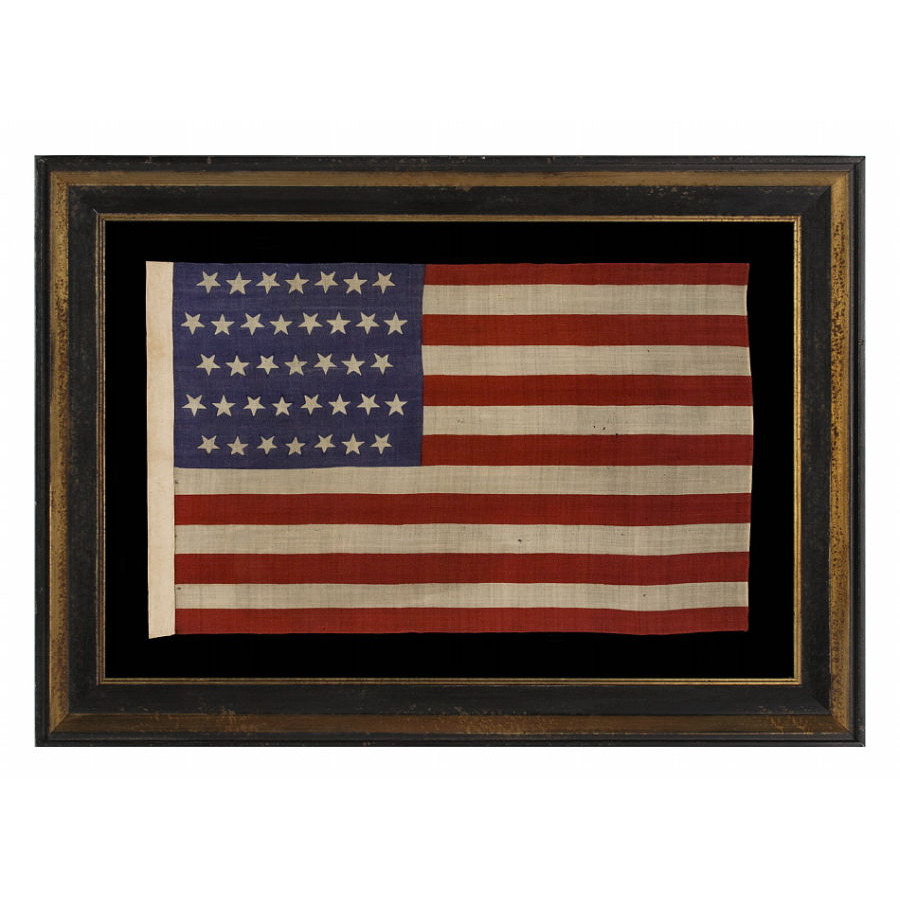
| |
37 DANCING OR TUMBLING STARS ON AN UNUSUAL PRESS-DYED FLAG OF THE 1867-1876 PERIOD, POSSIBLY AND INDIAN WARS-ERA CAMP COLORS, NEBRASKA STATEHOOD |
|
| Available: |
Sold |
| Frame Size (H x L): |
Approx. 30" x 47" |
| Flag Size (H x L): |
18.75" x 36" |
|
| Description....: |
|
37 DANCING OR TUMBLING STARS ON AN UNUSUAL PRESS-DYED FLAG OF THE 1867-1876 PERIOD, POSSIBLY AND INDIAN WARS-ERA CAMP COLORS, NEBRASKA STATEHOOD:
37 star American flag, press-dyed on wool bunting, with a hand-sewn cotton sleeve along the hoist and a hand-sewn binding at the fly end. The stars are arranged in lineal rows in counts of 7-8-7-8-7. Note how the vertical orientation of each star alternates from one to the next so that they are consecutively point-down, point-up, creating what I call a “tumbling” or “dancing” formation. This has a nice graphic impact. Also note the strong coloration in the attractive shade of indigo blue and scarlet.
The 37th state, Nebraska, joined the Union on March 1st, 1867. The 37 star flag was official from that year until 1877, although it generally fell out of use in 1876 with the addition of Colorado. The 37 star-count is scarce in comparison to those that immediately preceded and followed it. This is due primarily to the lack of major patriotic events during the period when 37 star flags were generally used, which followed the Civil War yet preceded the 100-year anniversary of our nation's independence. While the 37 star flag was still official in 1876, it was well known that at least one more state would be joining the Union that year. This caused flag makers to cease production in favor of 38 and 39 star flags. For this reason, 37 star flags were seldom produced for our nation's centennial, where 38 and 39 star counts were preferred, along with 13 star examples to commemorate the original 13 colonies. Even so, some 37 star flags survive that are known to have been made in the fanfare of our nation's 100-year anniversary.
Press-dyed wool flags are far more scarce than those printed on cotton and silk. The earliest examples were produced by Edward Brierly, a textile manufacturer in Lowell, Massachusetts, who received the first patent for the process in 1849. From this time until the Civil War period (1861-65), most of the flags produced in this fashion appear to have served a military purpose, either as camp colors or perhaps as flank markers when need arose.
By contrast, most small decorative flags were instead printed on cotton or silk. Called parade flags or hand-wavers, these were intended for one day’s use only at a specific parade, rally, or other patriotic event. Cotton and silk were ill-suited for exposure to moisture. Because wool sheds water, it was more appropriate extended outdoor use. In 1876, the Centennial International Exposition, a six-month-long World's Fair held in Philadelphia, required many small decorative flags that could withstand long-term exposure to the elements. The Horstmann Company appears to have made and sold many for this function.
Between the Civil War and 1876, very few flags were press-dyed, so this particular example is unusual. Whether it was produced for parade use or as a military camp colors or flank marker is unknown. The scale would be proper for either of the latter two purposes, but at the same time is very similar to that of the press-dyed decorative flags of 1876. Because this example has an open sleeve along the hoist, it could be easily affixed to a staff in traditional military fashion.
Whatever the case may be, I have a specific appreciation for printed wool flags due to their scarcity as well as their superior texture over most of their cotton and silk counterparts. Dyed wool bunting usually holds its colors well. That is certainly the case here, where attractive shades of indigo blue and deep scarlet red provide for strong contrast.
Mounting: Mounting: The flag has been hand-stitched to 100% natural fabric for throughout for support. The flag was then hand-stitched to a background of 100% cotton twill, black in color, which was washed to reduce excess dye. An acid-free agent was added to the wash to further set the dye and the fabric was heat-treated for the same purpose. The mount was then placed in a black-painted, hand-gilded and distressed Italian molding. The glazing is U.V. protective acrylic.
Condition: Excellent for the period. There is very minor mothing and there is very minor staining. Many of my clients prefer early flags to show their age and history of use. |
|
|
|
| Collector Level: |
Intermediate-Level Collectors and Special Gifts |
|
| Flag Type: |
Parade flag |
|
| Star Count: |
37 |
|
| Earliest Date of Origin: |
1867 |
|
| Latest Date of Origin: |
1876 |
|
| State/Affiliation: |
Nebraska |
|
| War Association: |
1866-1890 Indian Wars |
|
| Price: |
SOLD |
|
| |
Views: 2719 |
|
|
|

